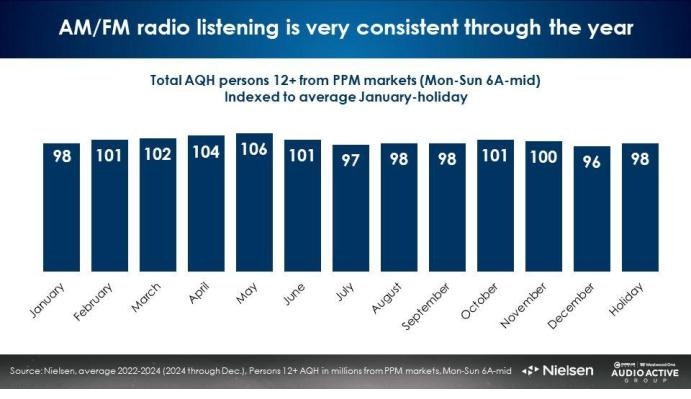Marketers and agencies have numerous questions about media planning (and audio specifically) and Pierre Bouvard, Chief Insights Officer of the Cumulus Media | Westwood One Audio Active Group, has a few answers in his latest post.
Among them: What are the ideal audio media plan allocations? Are there any seasonality patterns in AM/FM radio listening?
The data is sourced from Edison Research’s “Share of Ear” Report, Nielsen’s Nationwide, and Nielsen’s Media Impact, the media planning and optimization platform.
What are the ideal audio media plan allocations?
“Many media strategists and planners mistakenly believe Pandora and Spotify have the largest share of ad-supported audio listening,” Bouvard writes. “Perception is not reality. At a 66% share, Edison Research’s “Share of Ear” reveals AM/FM radio is the dominant ad-supported audio platform. A strong number two is podcasting.”
According to the Q2 2025 Edison “Share of Ear” study, AM/FM radio’s 66% share is 13 times larger than Spotify and 16 times larger than Pandora.

If I’m buying music streaming and podcasts, can I “check the box” on audio?
“Not so fast!” Bouvard warns. “If you only buy digital audio, you’ll miss 70% of America. Edison’s ‘Share of Ear’ reveals that the combination of Spotify, Pandora, and podcasts only reaches 30% of the U.S. on a typical day. The addition of AM/FM radio causes daily reach to soar to 75%.”
What is the ideal allocation of AM/FM radio weight by daypart? Is it true that radio is a “drive time” medium?
Says Bouvard: “Myth buster. No, AM/FM radio is not a ‘drive time’ medium. 58% of all U.S. AM/FM radio listening occurs outside of morning and afternoon drives!”
According to Nielsen, here is the ideal daypart allocation based on how Americans listen to AM/FM radio:
22% Monday-Friday, 6am-10am26% Monday-Friday, 10am-3pm20% Monday-Friday, 3pm-7pm7% Monday-Friday, 7pm-midnight20% weekends, Saturday-Sunday, 6am-midnight5% Monday-Sunday, midnight-6Aam
Are there any seasonality patterns in AM/FM radio listening?
“In short, no. Indexing aggregated monthly audiences from all Portable People Meter markets reveals exceptionally consistent listening levels throughout the year,” Bouvard writes. “Spring months are slightly higher than average while Summer months are ever so slightly below the annual average.”

What is AM/FM radio’s reach during major holiday weeks?
“Nielsen reveals holiday weekly reach of AM/FM radio is identical to typical weekly reach levels,” Bouvard writes. “As such, retailers with major holiday sales can confidently use AM/FM radio to get the word out about seasonal promotions.”
Can I generate meaningful incremental reach with the addition of AM/FM radio to the media plan?
“Yes! Major brands find that adding AM/FM radio to media plans can generate a significant lift in campaign reach,” Bouvard writes. “According to Nielsen Commspoint, the media planning platform, a reallocation of 20%-30% of the digital/TV budget to AM/FM radio generates significant lifts in incremental reach.
“For example, investment in digital and television results in a 27% reach. Shifting 30% of the media budget to AM/FM radio results in campaign reach jumping from 27% to 45%. This 30% reallocation to AM/FM radio generates a stunning +75% increase in reach for the same investment.”
If media strategy calls for increased reach among 18-49s, which media can generate the greatest lift?
“Look no further than AM/FM radio! According to Nielsen Media Impact, the addition of AM/FM radio to a digital/TV plan resulted in significant lift among 18-49-year-olds, ranging from 29% to 48%,” Bouvard writes. “This scenario shifted 20% of the digital/TV plan to AM/FM radio with no increase in budget.”

